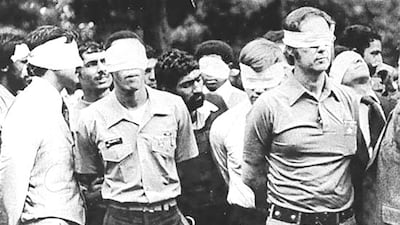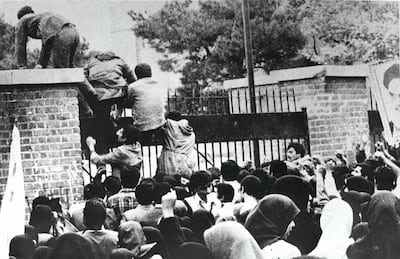As Iran marks the 40th anniversary of the country’s revolution, there is one group whose interest in those events is altogether different, having been subjected to a trauma that did more than anything to characterise the profound changes taking place in Tehran.
At the time of Ayatollah Ruhollah Khomeini’s return from exile on February 1, 1979, which heralded the fall of monarch Shah Mohammad Reza Pahlavi 10 days later, Don Cooke was a junior foreign service officer at the American embassy.
He watched over the next nine months as the newly formed Islamic Republic of Iran ended the influence of western-educated secularists who had controlled the levers of government. A wave of religious fundamentalism swept the capital, empowered local militias enforced the new rules and loyalists to the monarchy were executed.
The burning of American, British and Israeli flags symbolised the shift in power.
Mr Cooke was on duty in Tehran on November 4, when followers of Khomeini climbed the wall and entered the United States diplomatic compound. What happened next precipitated the darkest episode in Iranian-US relations and ultimately ended Jimmy Carter’s presidency.
“It was quite an experience but I was fairly young and very adaptable. My aim was to get back on a normal path as soon as possible,” says Mr Cooke, one of 52 Americans who were blindfolded, tied up and paraded in public after the embassy was overrun.
It took 444 days until an agreement for the release of the hostages was announced, moments after Ronald Reagan was sworn in as the 40th US president, on January 20, 1981.
To those involved, and to the American public, images of the US-Iran hostage crisis are scars, and a measure of the radicalism and savagery that Iran’s new rulers were prepared to support.
Placards placed in American front gardens alongside the Stars and Stripes displayed a clear message: “Bring the hostages home”. Yellow ribbons were also tied around trees as a mark of solidarity and hope.
After breaching the wall, the Iranian protesters, students mostly, who had been demonstrating since the early morning, smashed the embassy’s basement windows and moved inside.

Mr Cooke, 63, considers himself fortunate not to experience flashbacks of what he endured during detention, unlike many of his fellow captives. He was back on duty overseas by August 1981 and served in the State Department until 2012, working in France, Japan, Malaysia, the US, Portugal and Iraq.
But the event did affect his family and colleagues. “The tendency was for people to almost treat me with kid gloves, so hard were they trying not to upset me in some way,” says Mr Cooke, who divides his time these days between homes in Gaithersburg, Maryland in the US, and Manila.
His view on the past four decades of relations between Iran and the US – diplomatic ties were severed in 1980 – are that compromise or rapprochement will not be possible until a fundamental change takes place in Tehran. He calls the current situation a political “peacock show”, in which two rival protagonists routinely want to appear to exert the greater influence in the Middle East. It has amounted to a lasting enmity.
“This is a cultural thing between Americans and Iranians,” Mr Cooke says. “They will not fight for a losing cause if they see they are being overpowered. They will look for a way out. But if they sense weakness in you, they will do anything to maximise it.”
He believes the US policy on Iran is at risk of succumbing to a diplomatic form of carpal tunnel syndrome. Such is Mr Cooke’s assessment of much of America’s dealings with Iran, particularly that of the Obama administration’s nuclear agreement, the Joint Comprehensive Plan of Action. The deal was struck in 2015 and involved Tehran, the US and other western signatories – Britain, France and Germany – as well as China and Russia. President Donald Trump last year withdrew the US from the agreement, a decision Mr Cooke approves of.
“The political spectrum in Iran is narrow. So, any Iranian moderate, by virtue of their system, is a hardliner. If there is ever going to be a change, they need to come to us, not us to them,” he says, likening the situation to Chinese-US relations before Richard Nixon’s presidency. While Nixon visited Beijing in 1972, the original approach came from Mao Zedong, the founder of the People’s Republic of China and the country’s ruler, who was in ill health at the time and died four years later.
“If you said then that the US would have the relationship with China that it has now, no one would have believed you, so I haven’t totally given up on what might happen with Iran,” Mr Cooke says.
In Tehran today, the US embassy is an unofficial monument to the revolution. The boundary walls are adorned with anti-US graffiti, while the main entrance and the road outside are frequent meeting points for regime-orchestrated celebrations of the clerical theocracy that Khomeini established.
Rocky Sickmann, a US Marine sergeant from St Louis, Missouri, knew the embassy gates well. He had just finished guard duty and was eating breakfast when he heard chants from the streets outside calling for the US to return the Shah to Tehran for trial and an inevitable execution.
Then aged 22, Mr Sickmann prepared to head to the entrance but was told to stay where he was because the Iranian government had told US officials help was on the way. No one ever arrived.
He recalls being armed with a shotgun and a .38 pistol when the students, including women in black chadors, entered the building. In a candid admission, he says he was wrong to spare their lives.
“We held the crowd off for three hours. When they got in through the basement windows the men used the women as shields – I regret to this day that I never pulled that trigger,” says Mr Sickmann, 61, who lives in St Louis, having returned to the city after being freed.
“I truly believe the war on terrorism started that day. We were humiliated. As a Marine, though, we did what we were told to do: not to fire. But when you consider the US Marine barracks bombing in Beirut in 1983, you can see the consequences.”

That lorry bomb attack on the American base killed 241 Americans, including 220 Marines. A second co-ordinated lorry bomb nearby killed 58 French paratroopers. In 2003, a US federal judge said that Hezbollah, acting on Iranian orders, carried out the attacks.
In 2015, President Barack Obama signed a law that finally allowed the hostages to claim compensation for their incarceration in Tehran. The Algiers Accords that had ended the hostage crisis had specifically barred legal action against Iran.
When he learnt of the compensation provisions, Mr Sickmann recalls pulling his vehicle over at the side of a road and bursting into tears as he recalled the experience.
But as was predicted by many at the time the compensation announcement was made, the $4.4 million (Dh16.2m) each hostage was to receive – $10,000 for each day of detention – has only partly materialised.
Only 35 of the hostages are still alive and, so far, they have received 18 per cent of the promised settlement. That the families of those killed in the attacks on 9/11 can also claim compensation as victims of extremism has complicated the matter further, with lawyers saying that the Tehran embassy hostages’ cases are not straightforward.
Mr Sickmann’s recollection of being subjected to mock firing squads, particularly during the first 30 days of his detention, is followed by what appears to be another defining memory.
“Right from the start they told us they were using us,” he says of his interrogators. “They said: ‘It is not Americans that we hate, it is your government. But we know that your government only lasts four or eight years. We can wait. We will use you to humiliate your government.’ And that’s exactly what they did. They’ve been doing it ever since.”
As a US Marine, he feels particularly bad about the failed hostage rescue mission approved by the Carter administration. Operation Eagle Claw was a complex and ultimately doomed CIA plan that involved US Air Force helicopters and Delta Force soldiers, who landed in the Iranian desert and moved to the capital.
The rescue attempt was launched from Oman on April 24, 1980, but was aborted amid a sandstorm and a series of miscalculations. As one helicopter attempted to lift off from the staging point in the desert it crashed into an American transport plane, killing eight servicemen. The military debacle damaged US prestige and was a propaganda gift to Khomeini’s regime.
“For the first 30 days, we were tied up and not allowed to speak, but eventually we did start to learn about things that were happening,” Mr Sickmann says.
“When I found out about the eight people who lost their lives in the rescue mission it hit me hard. They never got the chance to build a life like I eventually did. Now, whenever I feel down about anything, I always think of them and it gives me the jolt I need.”
One of the oldest surviving hostages is Colonel David Roeder, who had only been in Tehran for eight days, as an ¬assistant air force attache.
Now 79 and living in Pinehurst, North Carolina, he is determined that the financial compensation promised is awarded while he is alive, although he has doubts that will happen.
He agrees with Mr Cooke about why there should be no diplomatic ties between the US and Iran. “I don’t see anything that could possibly make us seek diplomatic relations with a country that is uninterested in joining the community of nations,” he says.
“There is a whole lot of backing up that the Iranians have to do.”


